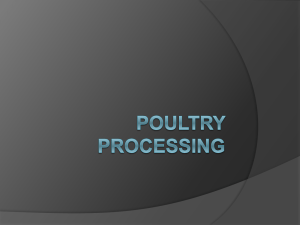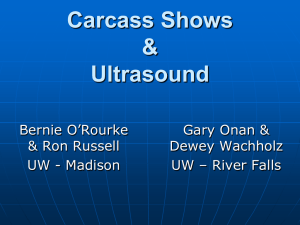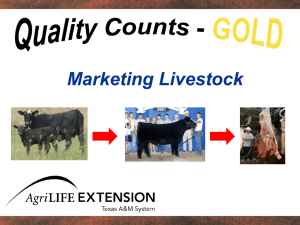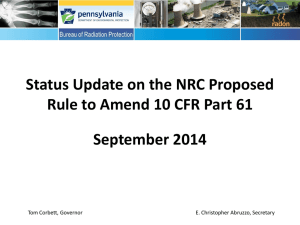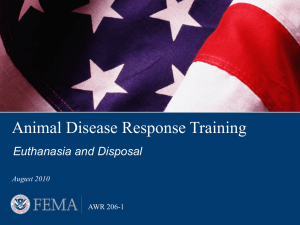Carcass Disposal: Overview - The Center for Food Security and
advertisement
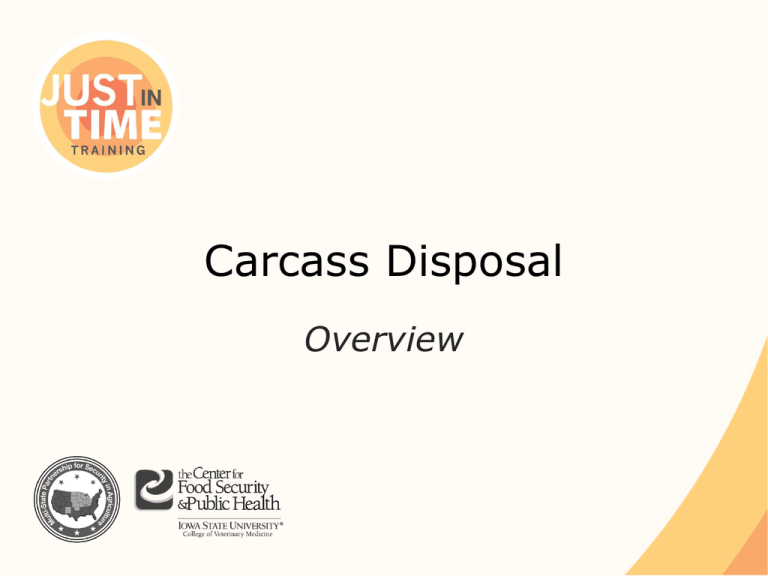
Carcass Disposal Overview Method Selection ● Animal species ● Number of animals – Space and equipment needed ● Pathogen and its ability to persist or spread Just In Time Training ● Environmental issues – Soil characteristics – Water sources – Air quality ● Public health issues ● Regulations Carcass Disposal: Overview CARCASS DISPOSAL METHODS • Burial • Subsurface Disposal/Landfills • Incineration • Composting • Rendering Just In Time Training Carcass Disposal: Overview Burial ● Excavated trench or pit – Decomposition and heat ● Puncture/vent carcasses – Minimize accumulation of gases – Displacement and shift of soil ● Soil characteristics critical Just In Time Training Carcass Disposal: Overview Burial: Construction and Design ● Trench area 4-8’ deep x 6’ wide ● Site size/area – Depends on species, age/size, quantity – 42 cubic feet per 1 adult bovine OR 5 pigs/sheep OR 40 chickens ● Liners to minimize seepage Just In Time Training Carcass Disposal: Overview Regulations and Monitoring ● Consult State regulations – Sites highly regulated – Depth, width, length, max size ● Environmental impact – Groundwater monitoring – Surface water sources – Air quality/odor ● Record site GPS location Just In Time Training Carcass Disposal: Overview Burial: Considerations ● Quick, easy, inexpensive ● Equipment generally readily available ● Takes large areas of land ● Difficult in cold weather conditions ● Environmental impacts – Water sources – Odor – Scavengers ● Public opposition Just In Time Training Carcass Disposal: Overview Landfills ● Public and privately owned – Licensed ● Existing site – Leachate and gas collection systems – Minimal environmental risk ● Highly regulated – Resources Conservation and Recovery Act (RCRA) ● Carcass degradation may take longer Just In Time Training Carcass Disposal: Overview Landfills: Considerations ● Immediately available ● Minimal environmental risk ● May have limited capacity ● Owner acceptance and terms of use ● Transportation – Biosecurity – Cost ● Public opposition Just In Time Training Carcass Disposal: Overview Incineration ● Thermal destruction – High-temp combustion – Various fuel sources ● Methods – Open-air burning – Fixed-facility incineration – Air-curtain incineration Just In Time Training Carcass Disposal: Overview Incineration: Considerations ● Complete combustion ● Limited capacity ● Air pollution ● Transportation – Biosecurity Just In Time Training ● Regulations – State approval for process – Licensing ● Trained personnel ● Public opposition Carcass Disposal: Overview Composting: Design ● Carcasses layered with organic material – Microorganisms heat pathogen destruction ● Indoor or outdoor – Bin or static windrow (pile) ● Requirements – Carbon:nitrogen ratio 25:1 to 40:1 ● Biofilter layer Just In Time Training Carcass Disposal: Overview Composting: Process ● Two phases – Active phase Aeration essential – Curing phase ● Monitor frequently ● Aeration ● Odor, vector control Just In Time Training Carcass Disposal: Overview Composting: Considerations ● On-site process ● Adaptable process ● Nutrient rich end product ● Transport of co-compost material ● Predators and scavengers Just In Time Training Carcass Disposal: Overview Rendering ● Off-site process – Transport of carcasses ● Heat conversion into – Meat and bone meal – Fat/Tallow – Water ● Dry rendering – Batch or continuous process ● Tell renderer cause of death Just In Time Training Carcass Disposal: Overview Rendering: Considerations ● Facilities have procedures for biosecurity, wastewater, byproducts ● Process closely regulated ● Transport of carcasses to site – Biosecurity – Leak proof containers – Coordination – Temporary storage may be needed Just In Time Training Carcass Disposal: Overview Alkaline Hydrolysis ● NaOH or KOH hydrolysis ● Sterile aqueous product ● Advantages – Highly automated – No emissions, minimal odor ● Disadvantages – Effluent disposal – Lack of availability Just In Time Training Carcass Disposal: Overview Carcass Disposal Considerations ● Site location – Soil topography and area Slope, permeability Proximity to water sources, public areas – Subsequent use of site – Regulations ● Environmental impacts – Water source contamination – Air quality – Scavengers Just In Time Training Carcass Disposal: Overview Carcass Disposal Considerations ● Biosecurity – Personal protective equipment – Movement control – Cleaning and disinfection ● Site security – Unauthorized persons – Log book – Warning or restriction signs – Site security personnel Just In Time Training Carcass Disposal: Overview Carcass Disposal Considerations ● Transporting infected materials – – – – Closed, leak-proof Liquid collection/absorption system Required permits Applicable laws/regulations ● Safety Issues – Physical and psychological ● Regulations ● Public perception Just In Time Training Carcass Disposal: Overview Disposal of Other Products ● Milk, wastewater, feed, grain, manure, bedding, wool ● Similar options as for carcasses ● Site selection guidelines apply ● Land application following treatment for manure, litter, slurry Just In Time Training Carcass Disposal: Overview Resources ● USDA Foreign Animal Disease Preparedness (FAD PReP) Guidelines: Disposal – http://www.aphis.usda.gov/animal_health/emrs/nahems .shtml ● USDA Foreign Animal Disease Preparedness Standard Operating Procedures (SOP): Disposal – http://www.aphis.usda.gov/emergency_response/tools/aphis_r ole_emergency_tools.shtml Just In Time Training Carcass Disposal: Overview Acknowledgments Development of this presentation was by the Center for Food Security and Public Health at Iowa State University through funding from the Multi-State Partnership for Security in Agriculture Authors: Molly Peebles, BS; Glenda Dvorak, DVM, MPH, DACVPM

